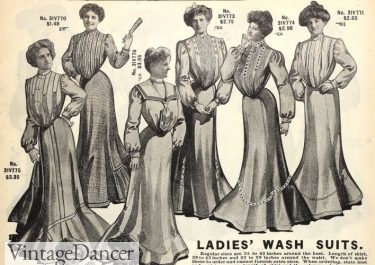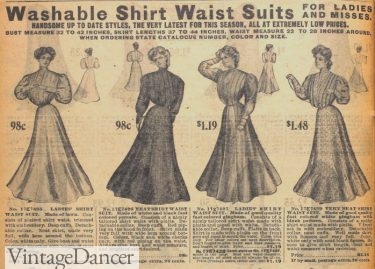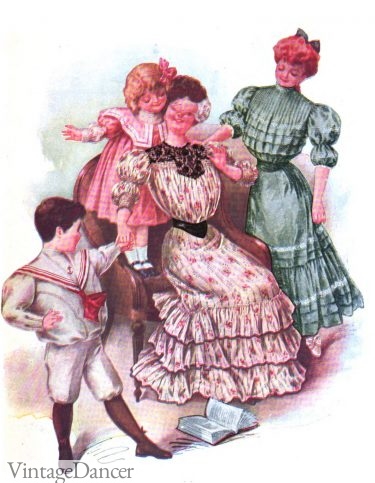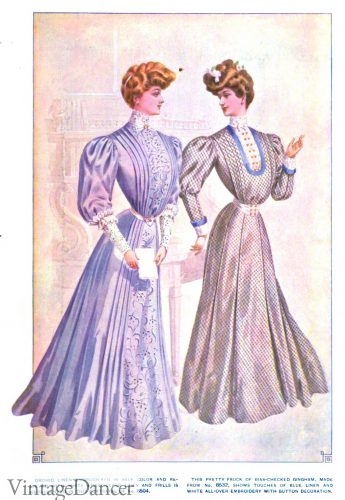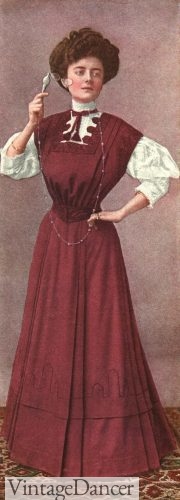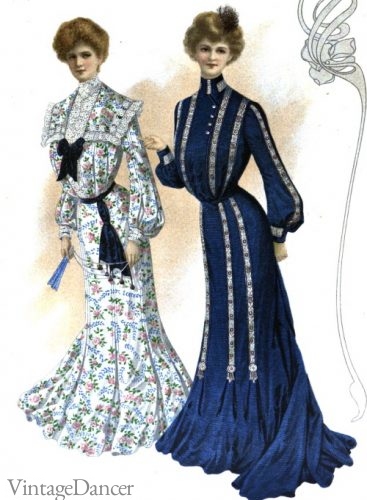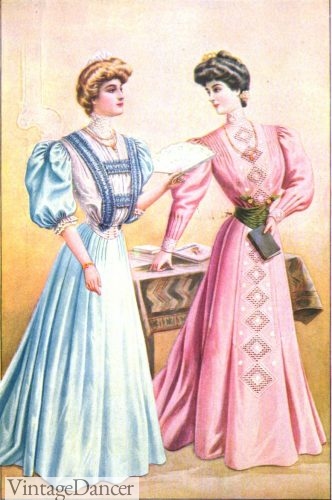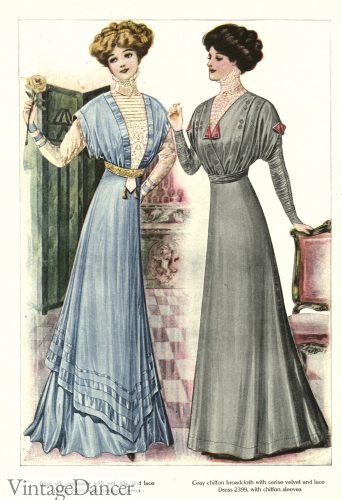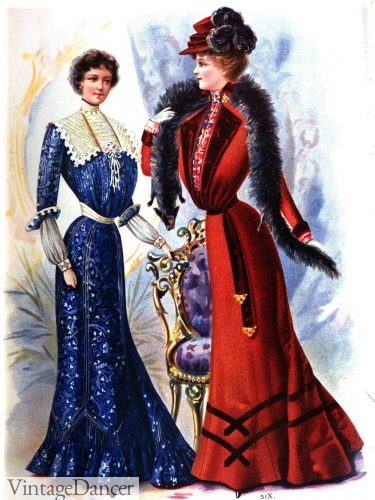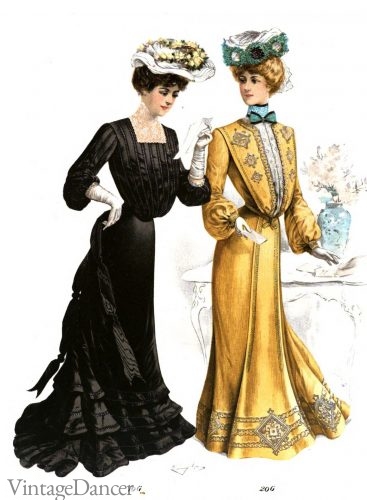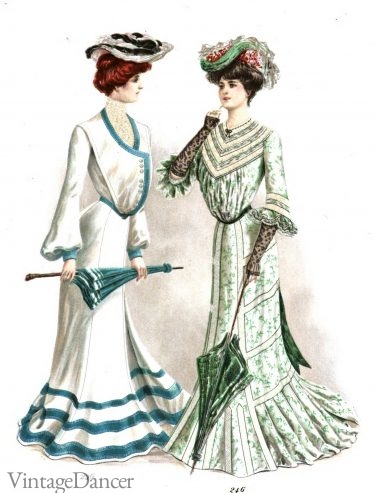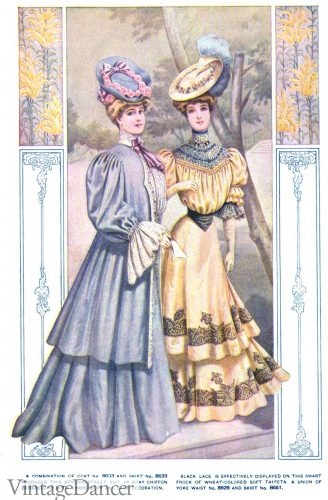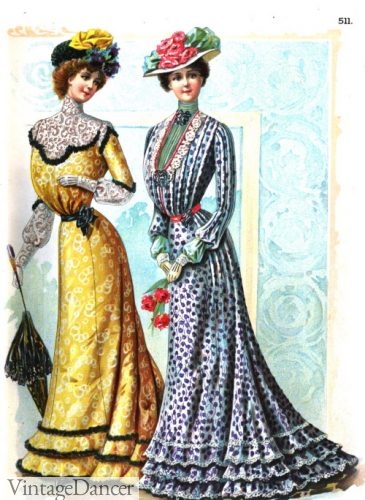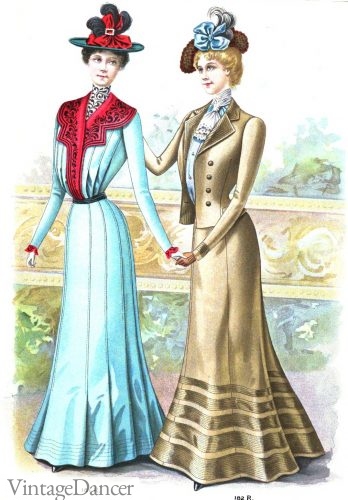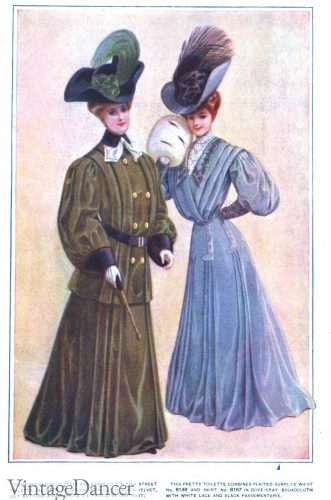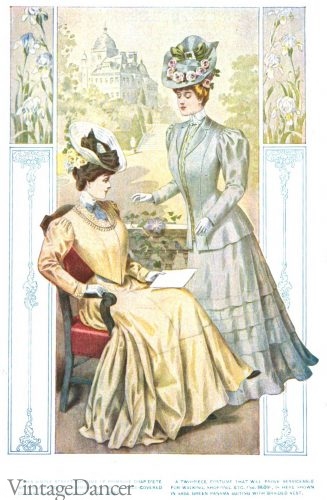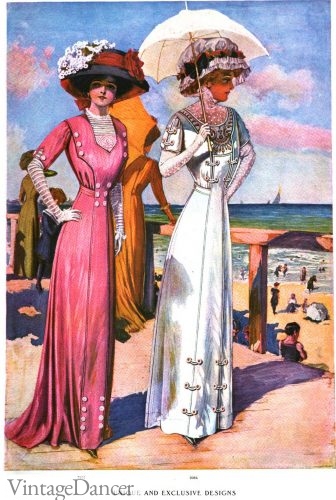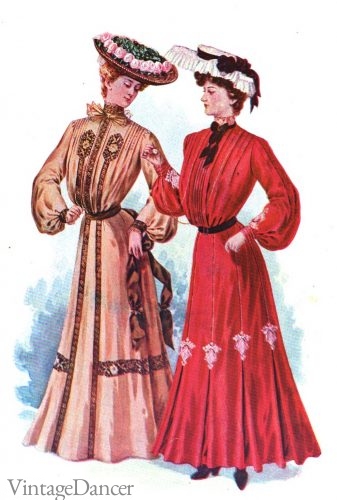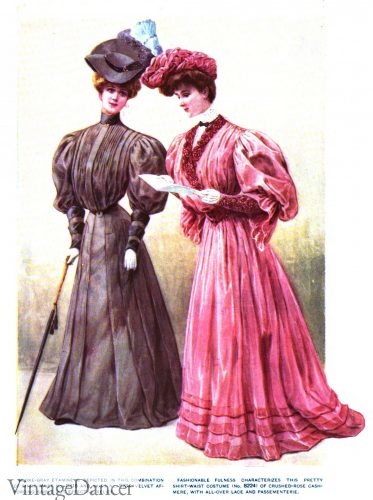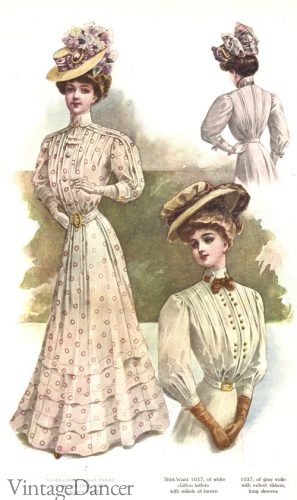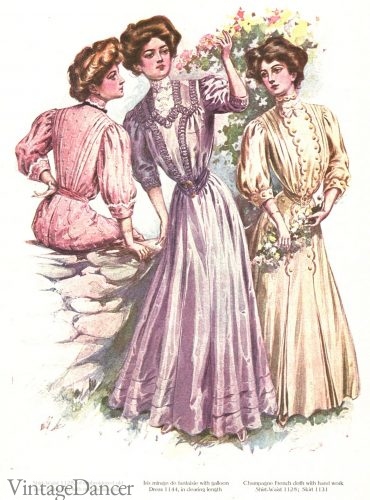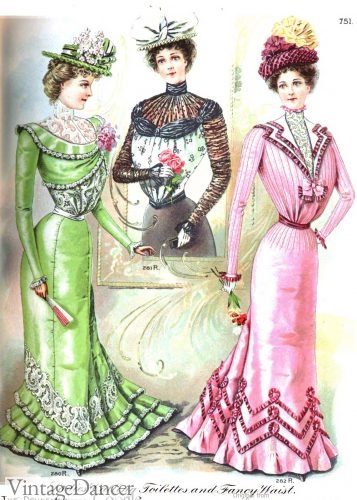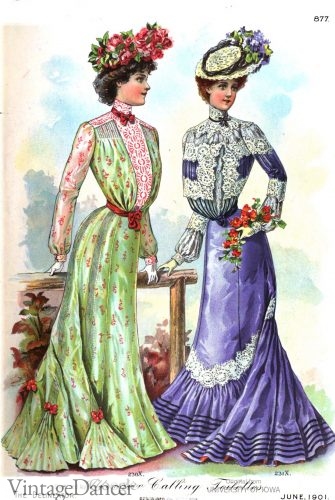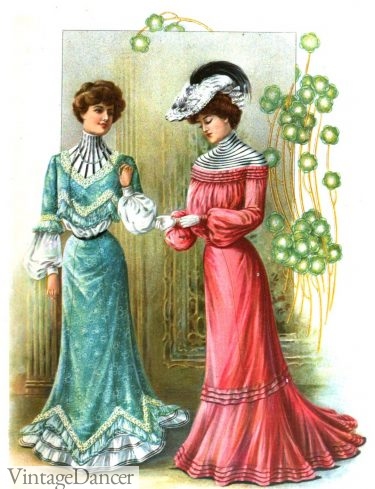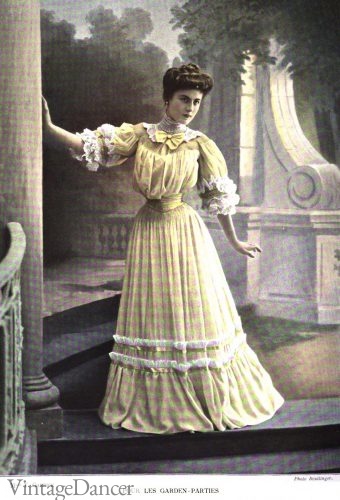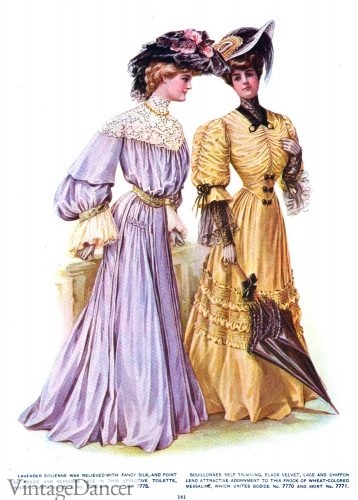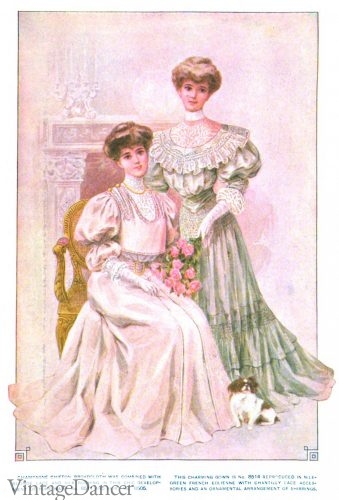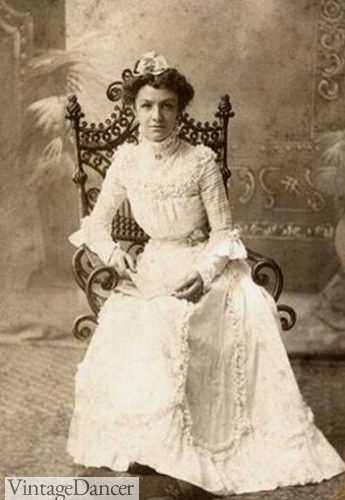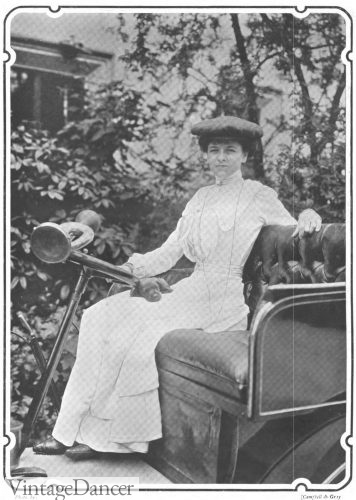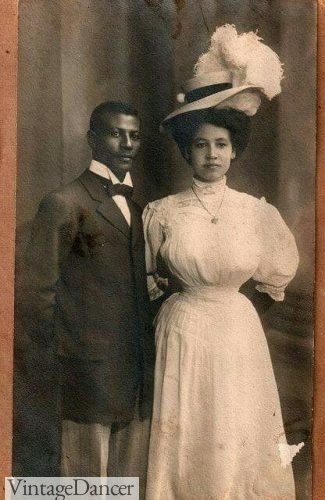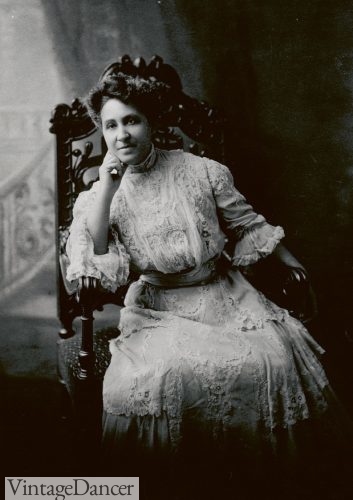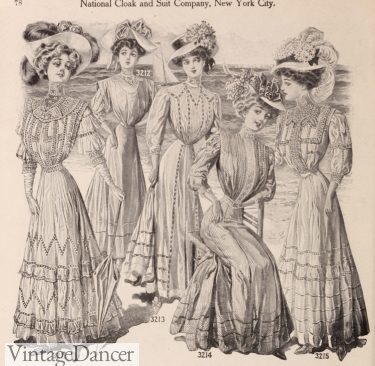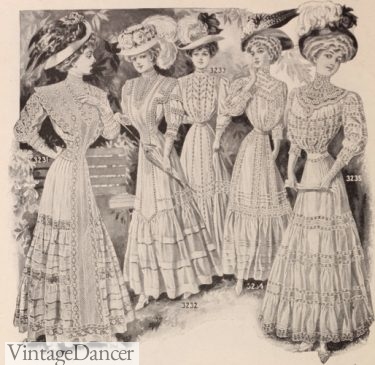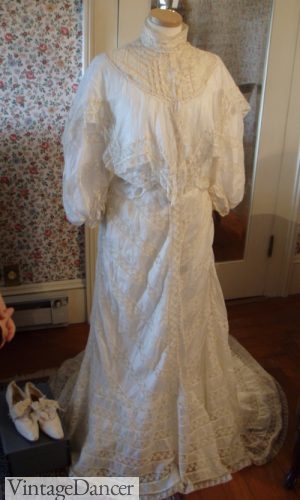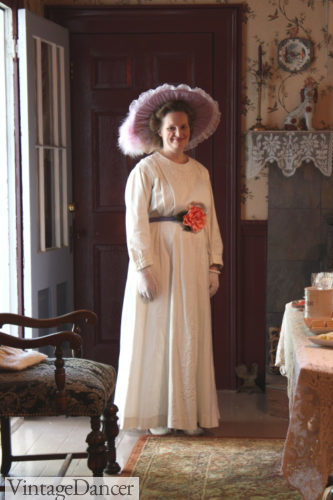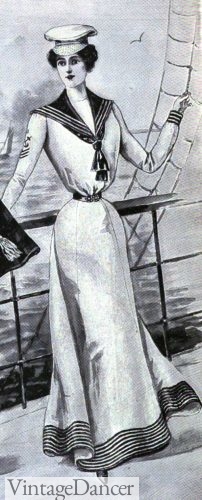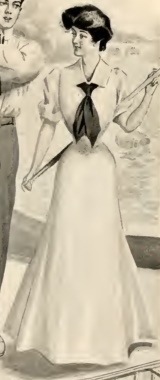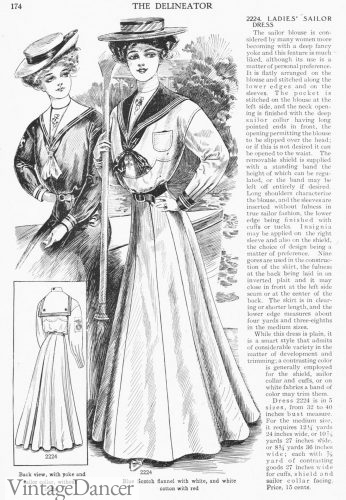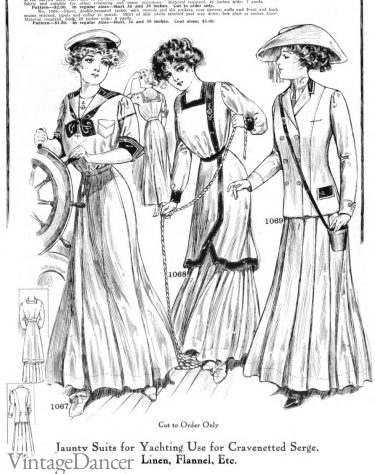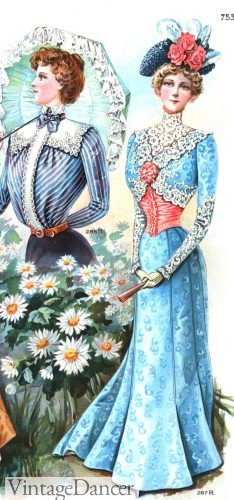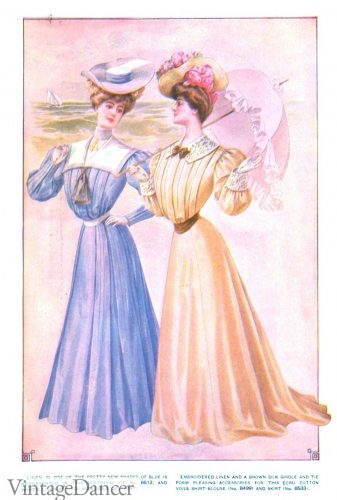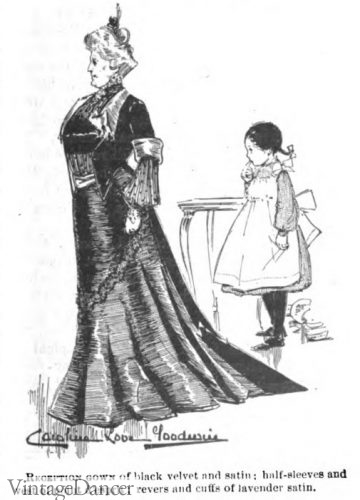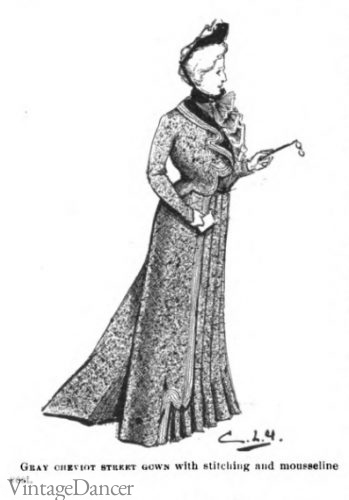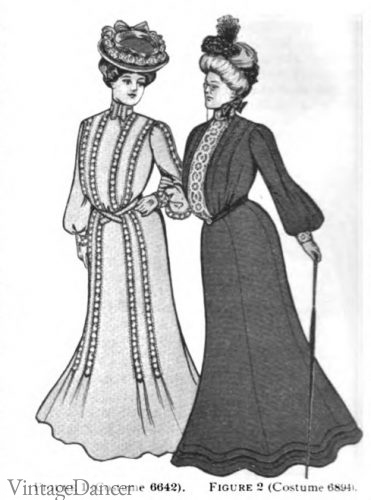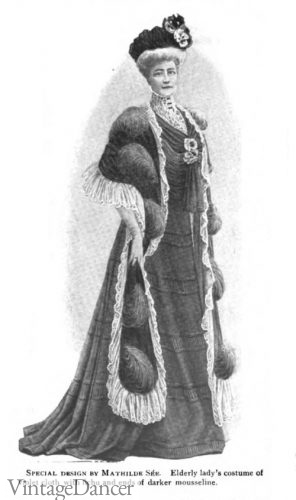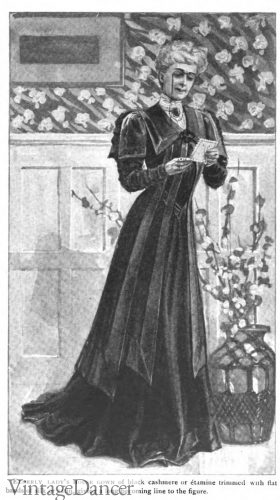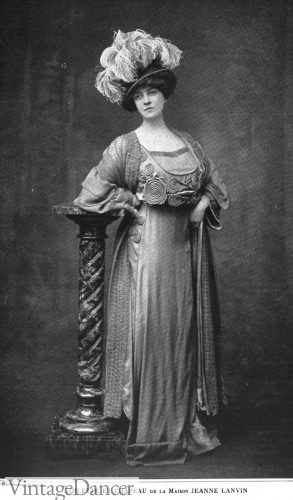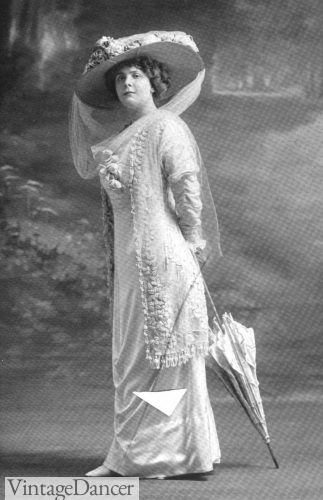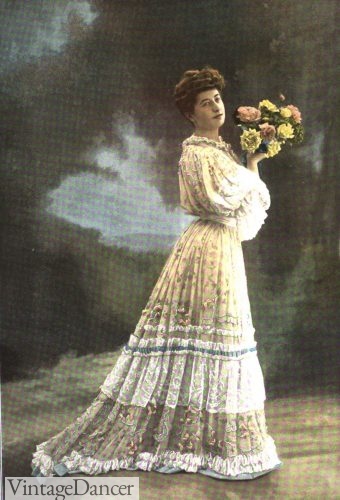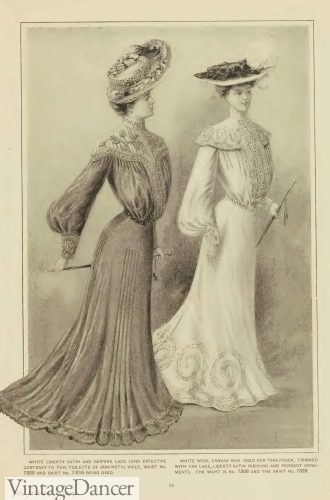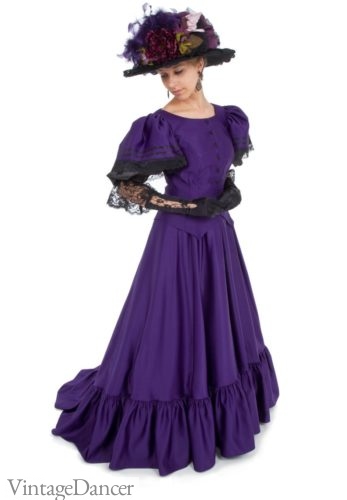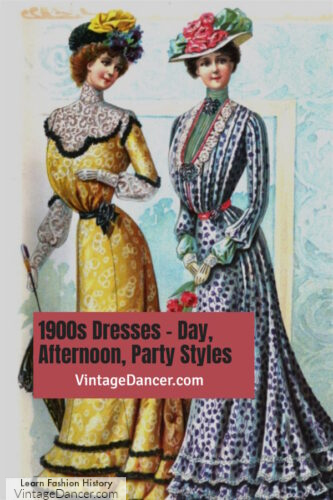
The 1900s, known as both the Edwardian era and La Belle Époque was a beautiful era for dresses. The invention of the “health corset,” later called the S-blend corset, altered the shape of women’s 1900s dresses from flat and vertical to curvy. The bust was thrust forward, the back curved inward, and the hips rounded. It wasn’t any more healthy than the Victorian era corset, but it was popular nonetheless. Dresses were designed around the new S-bend shape until 1908, when the silhouette changed again.
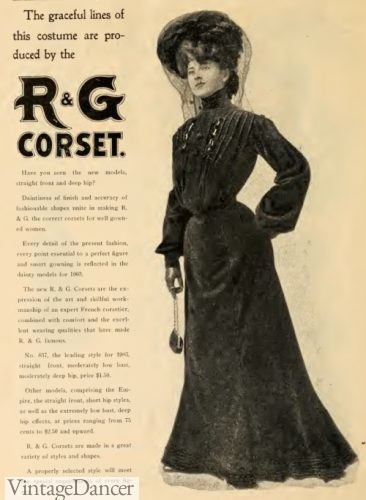
1903 R.G Corset with straight bust and deep hip create the look look of the 1900s
1900s dress skirts were bell shaped, sitting narrow at the waist and fuller at the hem. Gores or pleats were added, mostly at the back, to maintain a smooth front silhouette while remaining walkable. Ruffles, flounces, and pleats at the lower hem added to the skirt’s flare. Layers of petticoats created the volume underneath. The swish and sway of women walking across a room was romanticized in short stories and novels.
Walking skirts were hemmed just over the foot, while most day and afternoon gowns touched the floor with a small train. Middle classes and working women had no use for a train or frilly hemlines when life called for practical and simpler clothing. Narrow waistlines were still required however, sometimes accented by a separate belt or contrasting skirt waistband.
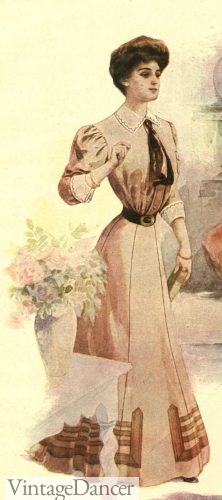
1907 bell shape skirt
Dress tops, called bodices or waists, had a very high and modest “dog collar” neckline. Long bishop sleeves ballooned at the wrist with a decorated cuff. Pleats, ruffles, pintucks, and lace filled out the bodice, exaggerating the S-bend bust. Embroidery and hand beading was added to all styles of day dresses, increasing as the years went by into the all over decorated “lingerie dress.” Layers of lace, ribbons, and flounces topped the lingerie dress in the later part of the decade and into the 1910s.
Dresses could be sewn as one piece, but were more commonly sewn as two separate pieces (bodice and skirt) attached together with small hooks and buttons. A matching jacket created the ladies’ suit ensemble — popular for streetwear, traveling, and middle classes. The blouse and skirt separates were another fashion that saw increasing popularity in the 1900s. Both ladies’ suits and skirt and blouse separates will be discussed in future articles.
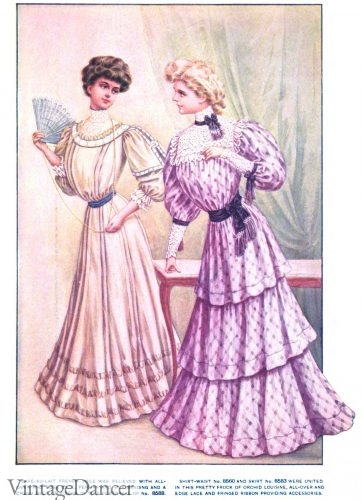
1905 shirtwaist dresses
The types of dresses for the upper classes and some middle class women were determined by time of day, season, and purpose of the outfit. After morning wrappers (robes) came house dresses, followed by reception dresses (worn at home), visiting dresses (worn to other homes), street costumes (for shopping and public gatherings), tea dresses (after 5pm but before dinner), and summer afternoon garden or indoor party dresses.
Dinner and evening gowns had their own designs. Specific styles for elderly women, teens, and stout sizes (plus sizes) added even more choices.
All of these 1900s dresses followed similar silhouettes, colors, and fabrics uses, yet had their own definable styles. Let us take a deeper look at each of these.
Wash Dresses
The middle and lower Edwardian classes as well as women living in the country may have had only one dress to wear all day. These practical dresses were made of washable cotton, hence the name wash dresses. They could be very simple house dresses, but fancier wash dresses were trimmed in affordable machine made lace, machine applied beads, or embroidery. Tan, white black, blue, and pink were essential colors in chambray, linen, lawn, sateen, percale, and madras fabrics.
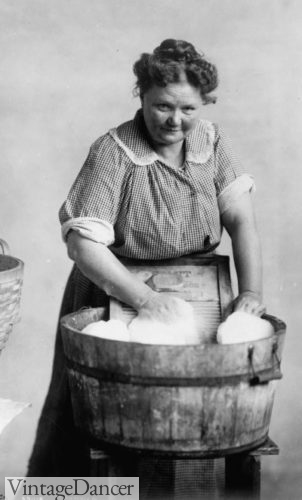
1905 Housewife
Most women handmade their own clothing, but the ready-to-wear mass merchandising market was growing leaps and bounds, making the latest fashions more affordable and accessible to even the remotest locations. Sears sold wash dresses in their catalogs for as little as $1 to up to $5 for a fancy dresses. That is the equivalent of $30 to $150 USA dollars in 2020.
- 1903 wash dresses, various styles, around $3 each
- 1906 wash dresses
- 1905 wash dress for busy mothers
- 1905 linen and gingahm cotton wash dresses
- 1907 jumper style wash dress
- 1909 fancy wash dresses
Reception Dresses
“It is important that a lady should always dress neatly at home. She is then ready to receive a morning caller without having to change her dress. ” – Household Companion: The Home Book Of Etiquette 1909
A wealthy woman would change out of here house dress and into a reception dress when she was expecting company (or hoped for an unexpected visit). They were reflective of her class and age, modest yet decorated in fabric that required more care with spot cleaning. Many dresses had small trains.
- 1900 striped reception dress with feather boa
- 1905 simple reception dresses
- 1908 day dress/reception dress
- 1909 reception dresses
There were also reception dresses for special events and weddings. These were either tea dresses for afternoon receptions or evening gowns for dinner receptions. See more about these under “fancy afternoon dresses.”
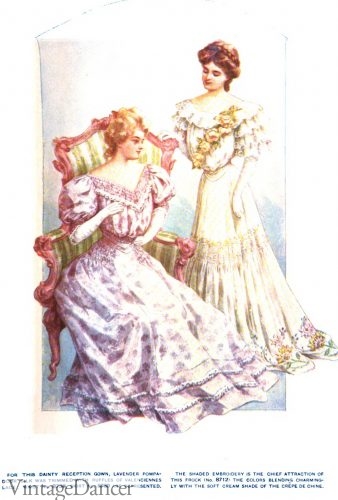
1905 afternoon reception party dresses
Visiting Dresses
Visiting dresses or afternoon dresses could also be the same as reception dresses, but trains were impractical if a woman was walking to her destination. They were usually more “suit-like” in appearance, with simple tops with some pretty decoration.
Skirts were also practical but elegant. Only if the occasion called for a fancier dress would women put on her silk and flouncy lace tea gowns.
- 1902 fancy and suit style afternoon dresses
- 1902 summertime afternoon dresses
- 1905 afternoon dress and overcoat
- 1909 afternoon dresses with lace inserts on the bodices
Street Dresses
“The walking-dress should be quiet. A rich or showy dress in the street is apt to attract more attention than is desirable or always agreeable. For the carriage, however, a lady may dress as elegantly as she wishes.” – Household Companion: The Home Book Of Etiquette 1909
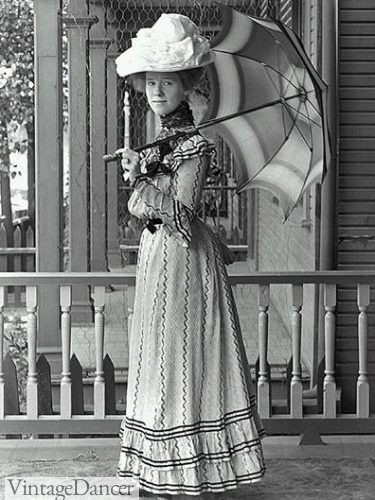
1900s walking dress with parasol
Walking with a dear friend, going for a carriage ride though the park, shopping, going to lunch, or attending public gatherings required women to dress in practical clothing.
For most women this meant a three piece suit, but there were some dresses that met the requirements as well. The primary difference is the length of the skirt. It needed to float above the ground, have a fuller skirt for easy walking and climbing into and out of carriages, and ample arm movement to hold up a parasol or umbrella.
For most seasons, a separate coat or jacket was worn over the dress as well as furs, muffs, gloves and a warm hat. In summer, a giant picture hat did plenty to keep the sun off the face.
- 1900 street dress and suit
- 1905 winter walking dress and coat
- 1905 walking dress and suit
- 1909 summer street dresses
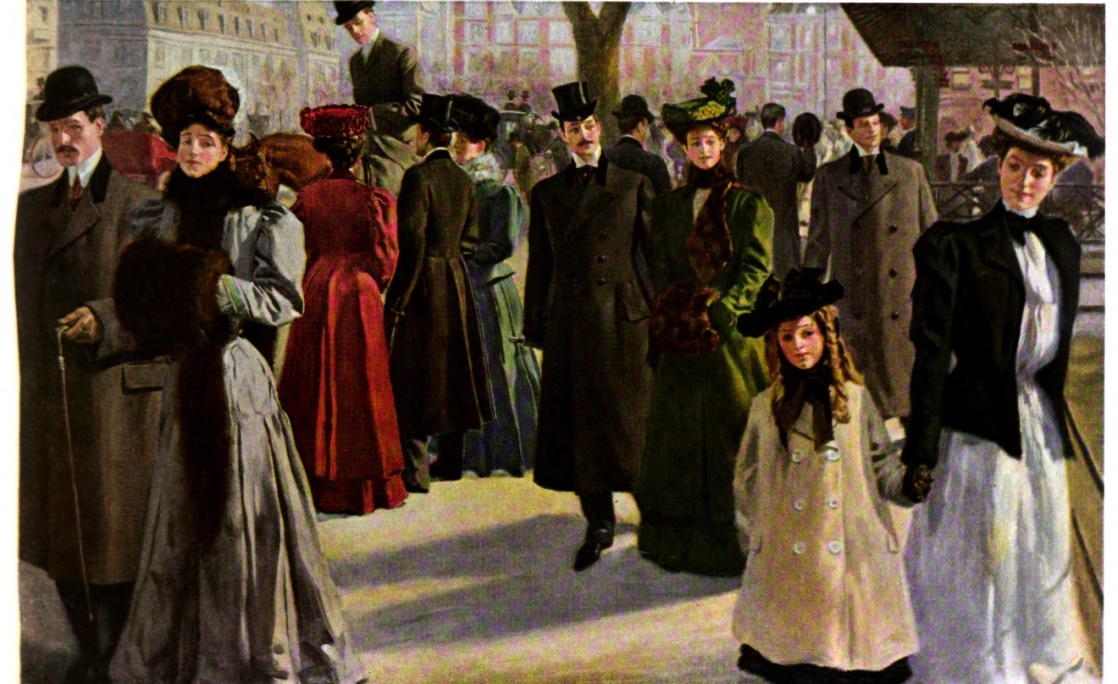
1905 street scene
Shirtwaist Dresses
Two piece dresses were called shirtwaist dresses. “Waist” was the name for a separate blouse. The shirtwaist dress was a gown that resembled a blouse on top and a dress skirt below, usually (but not necessarily) made of the same fabric. Mismatched waists could either be in the same color or a color that coordinated with the trim on the skirt.
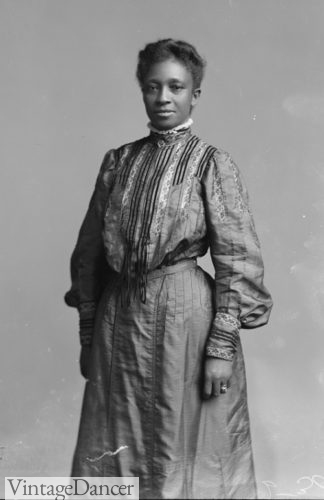
1903 Mrs. M.J Thompson
Shirtwaist dresses had a defined waistband or belt to differentiate them from one piece dresses. The tops featured bishop or mutton sleeves, high necklines, pintucks, or pleating for fullness and sometimes faux buttons down the front. Shirtwaist dresses continued to button at the back and not the front until the next decade.
Shirtwaist dresses were worn by all classes and for all types of daytime gatherings, including eveningwear. Women enjoyed the freedom the loose waist gave them over the previously tailored bodices.
- 1900 shirtwaist day dresses
- 1905 winter shirtwaist dresses
- 1907 printed shirtwaist dress
- 1907 tea party shirtwaist dresses
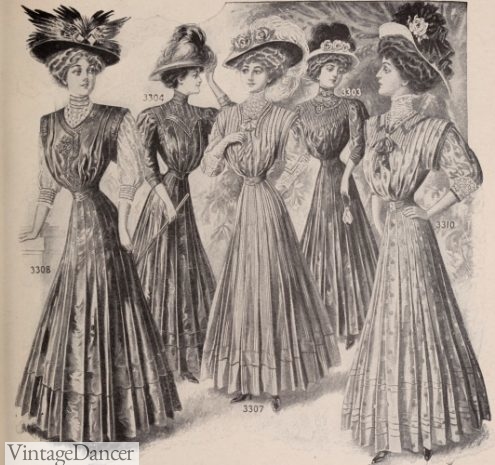
1908 shirtwaist dresses, middle class
Afternoon Fancy Dresses
Formal afternoon events such as wedding receptions, tea parties, luncheons, garden parties, and horse races required women to don their best, most fancy dresses. Unlike other more practical day dresses, these gowns had an excessive amount of trim, flounces, ruffles, lace inserts, beading, and embroidery up and down and all over the dresses. Most dresses had trains and most were in the shirtwaist style with extra full skirts after 1903. Coordinating hats were equally elegant.
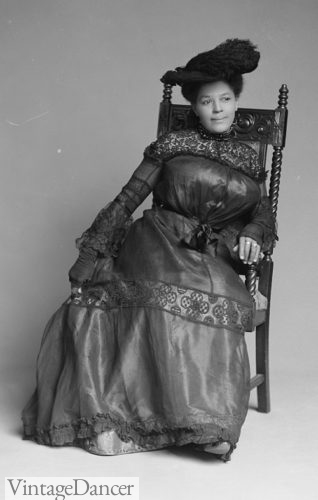
1903 Mrs. M.F. Reese
Afternoon party dresses were very colorful too. Their colors mimicked those found in a gardenL rose pink, stem green, bluebell, lilac, sunflower yellow, and teal water blue. They were absolutely dreamy!
- 1900 party dresses
- 1901 calling dresses, extra fine
- 1902 fancy afternoon dresses
- 1904 garden party dress
- 1904 fancy frocks
- 1905 fancy afternoon and evening gowns
Garden Party Dresses (white dresses)
After 1905, the white lingerie dress replaced most of the colorful party dresses. Women were infatuated with wearing white in public, especially when the hundreds of yards of lace, ruffles, and flounces exhibited their wealth. The upper middle classes also enjoyed white dresses, being careful not to dirty them too quickly. The cost was over $300 for a moderately decorated dress.
White dresses had been worn in summer for years prior to the lingerie dress trend too, often in simpler designs and more affordable fabrics.
The white Edwardian dress has historically been remembered as the fashion of the Edwardian era. It has experienced many revivals over the following centuries such as in the 1970s and 1980s, and again today with boho fashion and the cottagecore trend.
- Early 1900 white lace dress
- 1902 a white summer dress was frequently worn in women posing with their cars
- A handsome couple, a white tea dress with short sleeves
- Mary Church Terrell wears an elaborate white dress
- 1908 white dresses for the middle classes
- 1908 White Dresses for the Middle Class
- An original tea or wedding dress with alternative lace and ribbon inserts
- An Original Heavy Cotton Edwardian Era Dress Worn while I was 4m Pregnant
Sailor Dress
Second to the all white dress in summer was the yachting dress. Also known as a sailor dress, it was all white flannel, cotton, or linen fabric with a navy blue sailor collar, necktie, and cuffs. Navy dresses also existed with red accents instead. Many yachting themed outfits had only one element added to a white dress, such as the necktie or anchor motif embroidered on a sleeve.
For land vacationers at the seaside or beach, a white or subtle nautical color scheme dress (light blue or pink instead of navy blue or red) was a favorite to wear.
- 1900 Sailor Dress with Striped Skirt Trim
- 1907 white dress with sailor tie
- 1908 sailor blouses with blue or red trim and white skirts
- 1910 yachting themed dresses
- 1900 pastel nautical colors
- 1905 seaside themed summer dresses
Elderly Dresses
“Elderly ladies should dress as richly as their means permit. A thin old lady may wear delicate colors, while one of stout person or florid complexion will look best in black or dark grey. But for young and old alike the complexion and figure have much to do with determining the suitable colors. Rich colors harmonize well with brunette complexions, but for blondes and those of delicate tints of face the desirable colors to be worn are those of more delicate hue.” – Household Companion: The Home Book Of Etiquette 1909
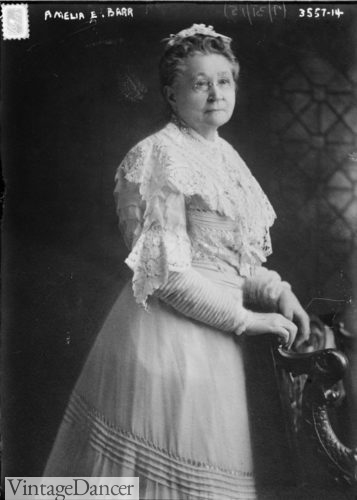
1910s Amelia Barr, lace trim dress
Advice for elderly women, which is to say any woman who has mature body and mind, were repeated a few times throughout the decade, even as fashions changed:
- The overall fit should look comfortable, not confining. Minimal boning in the dress bodice, and usually no bustles or padding support underneath.
- Dark colors – black, grey, and shades of purple were the safest. Pastels were too youthful and white brings out wrinkles.
- Rich heavy fabrics – brocades, sturdy silks, velvet, camel hair wool should be used over light chiffons. Choose matte over shiny fabrics and small prints over large ones.
- Dress line should be vertical, not horizontal. Vertical skirt panels, vertical pintuck bodices, vertical shawls and wraps, all make a stately appearance.
- Necklines in the V shape with a lace or chiffon collar, yoke, jabot etc is very becoming for mature women. Both black and white lace are encouraged.
- Trim in rich lace on the sleeves, necklines and bodice is encouraged. Trim should lay flat and not stand out too much. Jet or gold is also a good trim.
- 1901 reception dress- black velvet, lavender sleeves
- 1901 street dress- grey cheviot
- 1902 shirtwaist dress- vertical skirt panels, large white lace collar
- 1903 day dresses- vertical lines in bodice and skirt
- 1906 evening gown- V neck lined in white lace
- 1906 house dress- Velvet and black cashmere
Plus Size Dresses
What we call plus size today was called “Stout” in the 1900s. Being a curvy woman was a sign of wealth and good heath. There was little talk of making a stout woman appear thin, instead stout women’s fashions were designed to make her appear tall, strong, and regal. Here are a few suggestions:
- Avoid a short waistline. A longer waist that dips lower in front or a waistless dress is ideal.
- V or heart shape necklines, V pintucks/pleats, or lines of lace are flattering on all body types.
- The bodice should avoid puffs, flounces, and billows. Slender bodices that fit well, not too tight, are ideal. Sleeves should be fitted bishops, not large puffs.
- Muted, darker colors are better than light, white, or pastels. Solid colors are better than prints. Stripes only for the skirt.
- Avoid belts in contrasting color. Choose waistbands that match the dress. For this reason, shirtdresses are better than blouse and skirt separates.
- A 3/4 length coat or wrap adds height without bulk
A dedicated article to Edwardian plus size fashion can be read here.
Shop Edwardian era inspired plus size dresses.
- 1901 evening dress by Lanvin
- 1901 tea dress by Paquin
- 1904 vertical pleats dress skirt
- 1903 plain neck, V bodice, low waist- ideal dresses for plus figures
And that concludes our look at Edwardian era dresses for the 1900 to 1908 period. Take a look at the next series about the history of early 1910s dresses, the Titanic era.
Shop Edwardian Inspired Dresses
- 1900s Edwardian Dresses, 1910s Dresses
- Edwardian Evening Gowns , Ballgowns, Formal Dresses
- Plus Size Edwardian Clothing 1900 1910s
- Victorian – Edwardian Wedding Dresses, Shoes, Accessories
Read more
- Edwardian Stockings, Hose Socks 1900s -1910s
- Edwardian Handbags, Purses History 1900 & 1910s
- 1900s Costume & Outfit Ideas for Ladies
Debbie Sessions has been teaching fashion history and helping people dress for vintage themed events since 2009. She has turned a hobby into VintageDancer.com with hundreds of well researched articles and hand picked links to vintage inspired clothing online. She aims to make dressing accurately (or not) an affordable option for all. Oh, and she dances too.
